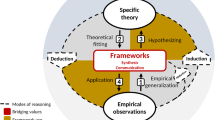Abstract
The Ethical Matrix was developed to help decision-makers explore the ethical issues raised by agri-food biotechnologies. Over the decade since its inception the Ethical Matrix has been used by a number of organizations and the philosophical basis of the framework has been discussed and analyzed extensively. The role of tools such as the Ethical Matrix in public policy decision-making has received increasing attention. In order to further develop the methodological aspects of the Ethical Matrix method, work was carried out to study the potential role of the Ethical Matrix as a decision support framework. When considering which frameworks to apply when analyzing the ethical dimensions of the application of agri-food biotechnologies, it is important to clarify the substantive nature of any prospective framework. In order to further investigate this issue, reflections on the neologism “ethical soundness” of an ethical framework are presented here. This concept is introduced in order to provide more structured evaluations of a range of ethical tools, including ethical frameworks such as the Ethical Matrix. As well as examining the philosophical dimensions of the method, theoretical analysis and literature studies were combined with stakeholder engagement exercises and consultations in order to review the Ethical Matrix from a user perspective. This work resulted in the development of an Ethical Matrix Manual, which is intended to act as a guide for potential user groups.
Similar content being viewed by others
References
Beauchamp T. L., Childress J. F. (2002). Principles of Biomedical Ethics, 5th edn. Oxford University Press, Oxford
Chadwick R. S., Henson B., Moseley G., Koenen M., Liakopoulos C., Midden A., Palou G., Rechkemmer D., Schroeder D., von Wright A. (2003). Functional Foods. Springer Verlag, Berlin
FAO/WHO (2003), FAO/WHO expert consultation on the safety assessment of foods derived from genetically modified animals including fish, November 2003, Rome: FAO/WHO, pp. 17–21
Føllesdal D., Walløe L., Elster J. (1986). Rationale Argumentation. W. de Gruyter, Berlin, New York
Forsberg, E. M. (2007), “Value Pluralism and Coherentist Justification of Ethical Advice.” Journal of Agricultural and Environmental Ethics, 20. Doi: 10.1007/S10806-006-9017-16
Kaiser, M. (2004), “Xenotransplantation – Ethical Considerations Based on Human and Societal Perspectives,” in W. Farstad, Ø. Andresen, O. Nyberg, and B. Christensen (eds.), Acta Veterinaria Scandinavica, Proceedings of the 16th Internordic Symposium of the Nordic Committee for Veterinary Scientific Cooperation on Animal Organs to Save Human Lives, Suppl. 99, pp. 65–73
Kaiser M., Forsberg E. M. (2001). Assessing Fisheries – Using an Ethical Matrix in a Participatory Process. Journal of Agricultural and Environmental Ethics 14: 192–200
Mepham, B. (1996). “Ethical Analysis of Food Biotechnologies: An Evaluative Framework,” in B. Mepham (ed.), Food Ethics, London: Routledge, pp. 101–119
Mepham B. (2000). A Framework for the Ethical Analysis of Novel Foods: The Ethical Matrix. Journal of Agricultural and Environmental Ethics 12: 165–176
Mepham B. (2001). Novel Foods. in: Chadwick R. (ed.) Concise Encyclopaedia of Ethics and New Technologies. Academic Press, San Diego, pp. 300–313
Mepham B. (2005). Bioethics: An Introduction for the Biosciences. Oxford University Press, Oxford
Mepham, B. and S. Tomkins (2003), Ethics and Animal Farming: An Interactive Web Program. www.ethicalmatrix.net
Mepham B., Kaiser M., Thorstensen E., Tomkins S., Millar K. (2006). Ethical Matrix User Manual. Agricultural Economics Research Institute, The Netherlands
Millar K. (2002). Thinking about Cleaning Up: The Ethics of Bioremediation. Science and Public Affairs 3: 20–21
Moore, C. J. (1996), A Bioethical Analysis of Transgenesis in Animals. PhD thesis, University of Nottingham
Schroeder D., Palmer C. (2003). Technology Assessment and the Ethical Matrix. Poiesis Praxis 1: 295–307
Acknowledgments
This work was conducted as part of the EC funded project under DG Research, FP5, Quality of Life program, “Ethical Bio TA tools,” (QLG6-CT-2002-02594). The funding and the inspiring collaboration of all other consortium members are gratefully acknowledged.
Author information
Authors and Affiliations
Corresponding author
Rights and permissions
About this article
Cite this article
Kaiser, M., Millar, K., Thorstensen, E. et al. Developing the ethical matrix as a decision support framework: GM fish as a case study. J Agric Environ Ethics 20, 65–80 (2007). https://doi.org/10.1007/s10806-006-9023-8
Accepted:
Published:
Issue Date:
DOI: https://doi.org/10.1007/s10806-006-9023-8




